How to AirPlay to Your Mac
Back when I was first working on Take Control of Apple TV in 2014, which was about AirPlay as much as the Apple TV itself, I thought to myself how nice it would be if I could AirPlay content from my iPhone to the larger screen of my Mac when in my office. Years passed, and I gave up on Apple ever offering such a feature, but then Apple surprised me by announcing AirPlay to Mac in macOS 12 Monterey.
The question is: who wants to use AirPlay to send audio or video from an Apple device to a Mac? If our recent survey of TidBITS readers is anything to go by, the answer is: maybe not many (see “Survey Results: Which iOS 15 and macOS 12 Monterey Features Do You Actually Use?,” 8 August 2022). In the survey, 74% of respondents reported never having used the feature, with 21% saying they used it occasionally and only 5% using it frequently. In an era of ubiquitous access to cloud-based services, AirPlay may not be as relevant as it once was, but there are still times when being able to AirPlay to a Mac could be a helpful trick, especially if you connect a Mac mini to your TV as a home entertainment device.
Another use case you may appreciate is AirPlaying audio from your iPhone to your Mac. Your Mac undoubtedly has better speakers than your iPhone, so you get better audio quality while sitting at your desk. Plus, you can use your iPhone as a remote control device if that’s more convenient than fussing with apps on your Mac. Lastly, if you need to leave your desk, you can turn off AirPlay on your iPhone to keep playing the audio without missing a beat. This approach works particularly well with apps like Overcast that aren’t native to the Mac. Instead of messing with the minimalistic Overcast Web interface and hoping it syncs correctly, you can AirPlay from the Overcast iPhone app to your Mac.
AirPlay to Mac Preliminaries
The receiving Mac must be in the list below and running Monterey for AirPlay to work:
- iMac (2019 and later)
- iMac Pro
- MacBook Air (2018 and later)
- MacBook Pro (2018 and later)
- Mac mini (2020 and later)
- Mac Pro (2019)
Also, make sure that AirPlay Receiver is enabled on your Mac. It should be on by default, but check by going to System Preferences > Sharing and making sure that AirPlay Receiver is selected. You can also choose to restrict AirPlay to the Apple ID tied to the current user or anyone on the same network, and you can set an AirPlay password to restrict access further if you have office or family pranksters.
As far as the iPhone goes, you need only an iPhone 7 or later. Apple says that even older iPhones may be able to AirPlay to Macs at a lower resolution if you enable Everyone in System Preferences > Sharing > AirPlay Receiver.
AirPlay Audio to a Mac
AirPlaying audio is the simplest and maybe the most useful, so we’ll start there. All you have to do is initiate AirPlay from your device and select the Mac as the target.
In iOS and iPadOS, the easiest method is to look for the AirPlay icon in your audio app—it looks like a triangle topped with three circles. I’ve highlighted examples from Audible, Music, and Overcast in the screenshot below. Tap the AirPlay icon, select your Mac, and the audio should start. If you can’t hear anything, you may need to turn up the volume on your iPhone or iPad and the receiving Mac.
YouTube is a little tricker. You have to tap the Chromecast icon and then AirPlay & Bluetooth Devices.
If your preferred app doesn’t have an obvious AirPlay icon, you can initiate AirPlay from Control Center. Tap the AirPlay icon in the upper-right corner of the media player control and select your Mac as the output device.
Mac apps don’t tend to have AirPlay icons. One notable exception is Music, which displays a pop-up menu that lets you select multiple AirPlay receivers. You can use that feature to fill your entire house with audio by selecting other Macs, HomePods, and even Apple TVs. This is one of Music’s underappreciated features, and it has only improved over the years as Apple has expanded AirPlay’s reach.
The best way to send AirPlay audio from a Mac is through Control Center in the menu bar. Click the AirPlay icon in the Sound controls and select an output device. Note that this causes all media audio to be played through that AirPlay receiver, but system-generated sounds remain local to your Mac.
Control Center also lets you view and control playback of all audio streams on your Mac, both incoming and outgoing. The most recent media stream appears at the bottom of Control Center, and if you click it, you’ll see all the other streams on your Mac. (Tip: Command-click an app’s stream in this list to switch to that app.)
AirPlay Video to a Mac
AirPlaying video works the same way in iOS and iPadOS: tap the AirPlay icon in an app or go through Control Center.
From a Mac, it’s a little trickier and must be triggered on a per-app basis. Two apps that support AirPlay are Apple’s QuickTime and TV apps, which display an AirPlay icon in the control panel. Note the AirPlay video icon has the triangle topped with a rectangle.
Safari also includes AirPlay support. Video sites like YouTube (shown below) that offer AirPlay features provide an AirPlay icon. However, other sites, like Amazon Prime Video, do not support AirPlay.
Unfortunately, receiving AirPlay video on your Mac takes over your entire machine. Video is played fullscreen, with no option to shrink it to a window. Plus, if you have multiple monitors, those not used for AirPlay are blacked out entirely. You can switch video between monitors by moving the pointer and using a menu in the upper-left corner, but no matter what, your Mac is temporarily unusable for anything else.
Exit AirPlay on the receiving Mac at any time by pressing Escape.
Screen Mirroring to a Mac
You can also use AirPlay to mirror one device’s screen to a Mac, which could be extremely effective when demoing something on an iPhone or iPad to other people. It’s trivial to initiate in iOS or iPadOS. Open Control Center, tap the Screen Mirroring button, and select your Mac as the destination device. Unfortunately, screen mirroring works like video—the iPhone’s or iPad’s screen takes over the entire Mac screen.
The process is similar on the Mac. Open Control Center, click the Screen Mirroring button, and select the destination Mac. However, there’s one significant difference. When you select the destination Mac, you can choose between mirroring and using it as a separate display. In this situation, taking over the destination Mac’s screen feels appropriate, though any secondary displays on the destination Mac are still ignored.
However, if you have dreams of using an older iMac as a secondary display using AirPlay, let me put an end to those right away. The resolution on the destination Mac will likely be problematic, and performance isn’t very good. When we tested this with an M1 MacBook Air using a 2020 27-inch iMac as a destination, AirPlay defaulted to the iMac screen’s native resolution, which resulted in too-small pixels. But selecting the normal 2560×1440 resolution in System Preferences > Displays > Display Settings lived up to the “low resolution” tag that appeared next to it in the list, as you can see in the oddly fuzzy screenshot below. You might be able to find a resolution that’s crisp and provides enough screen real estate to be useful, but it’s not guaranteed.
AirPlay to Mac may not be the killer feature we imagined in the early days of AirPlay, but it’s legitimately useful in all its combinations, so keep it in mind whenever you wish you could display something on a larger or additional screen.
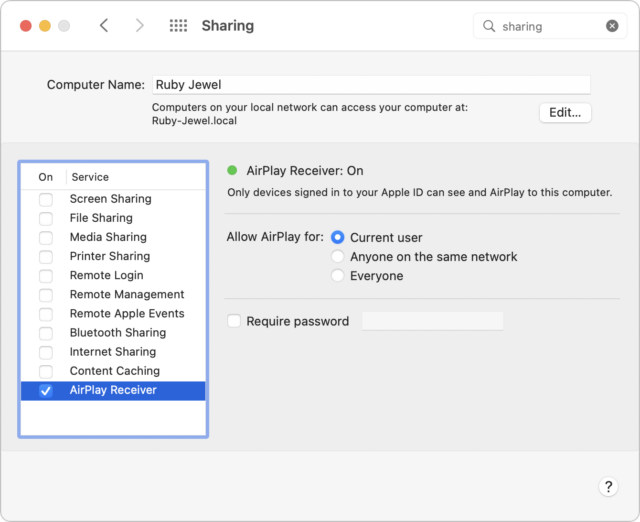
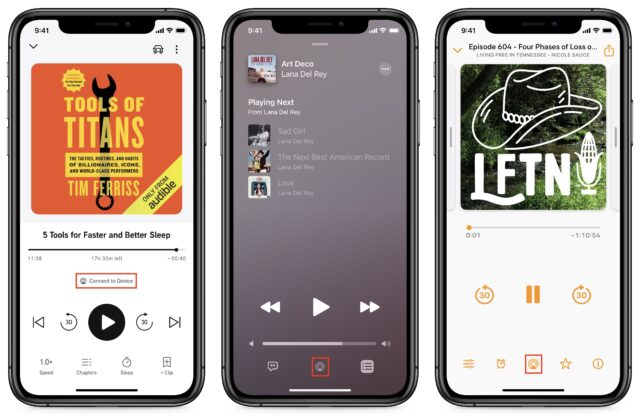
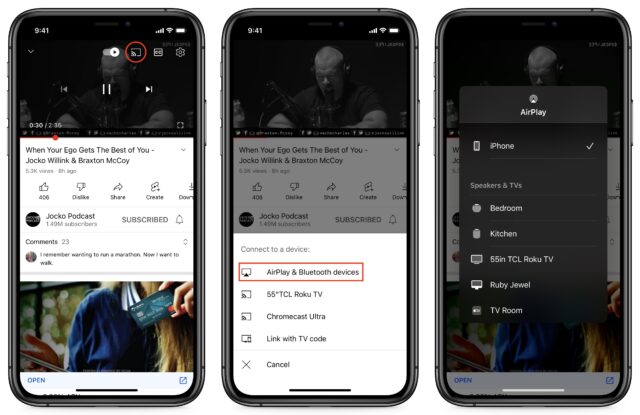
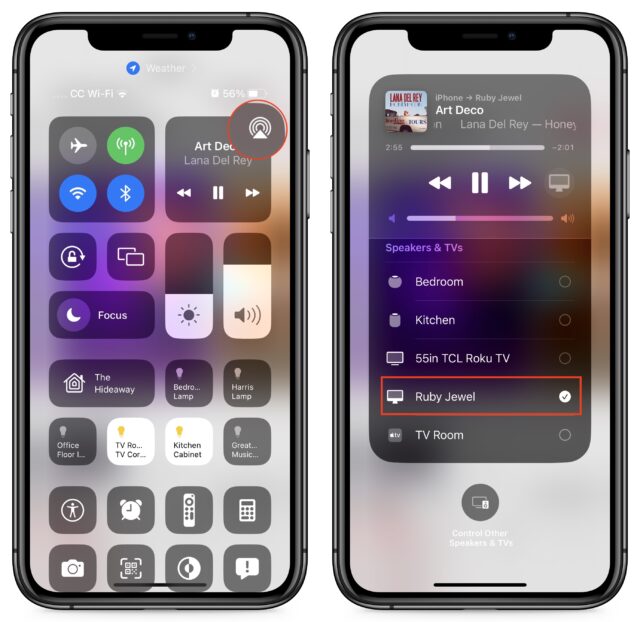
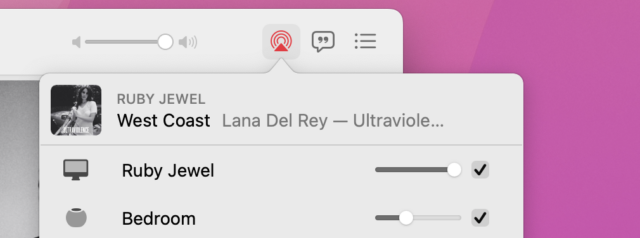
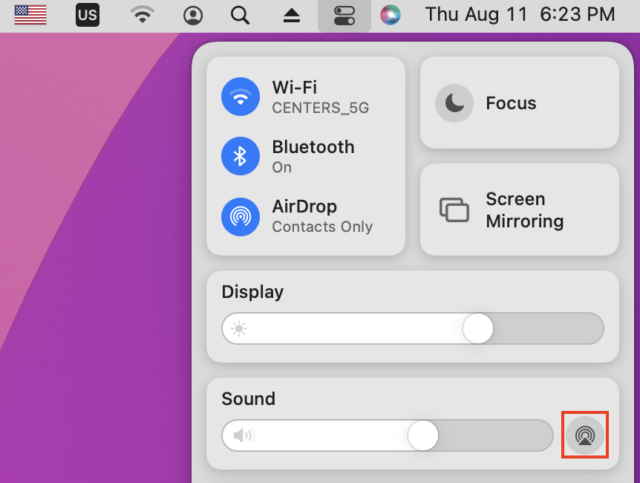
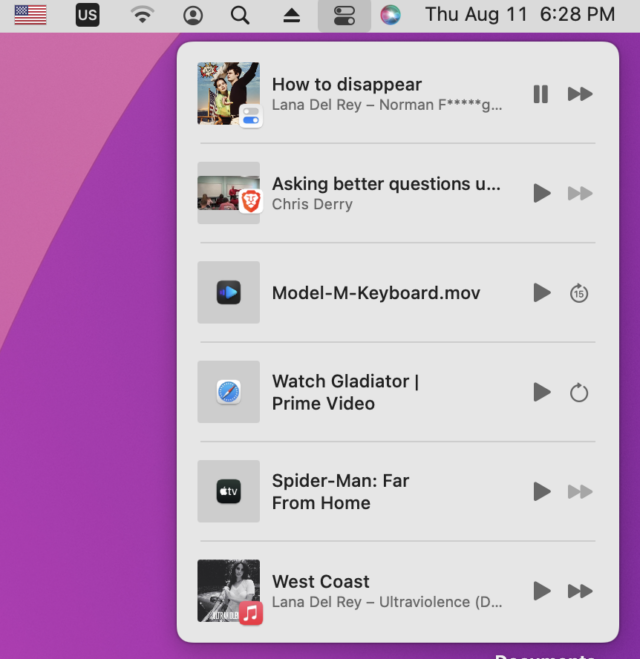

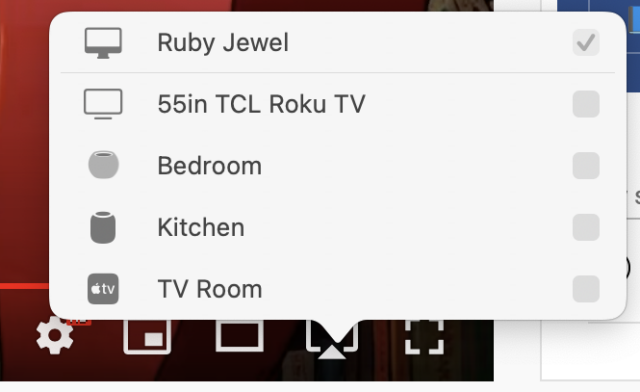

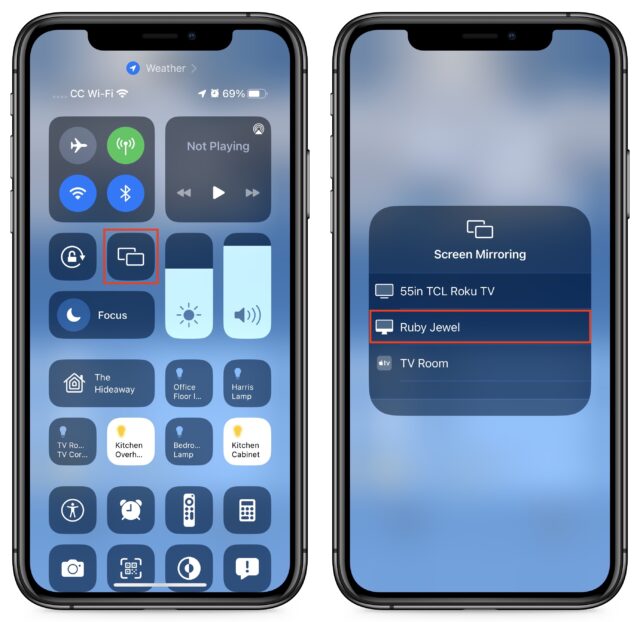
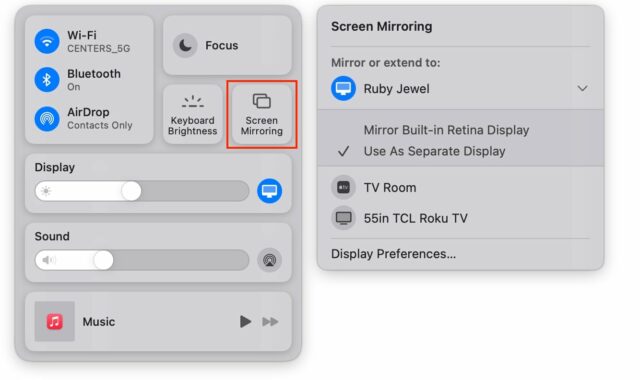
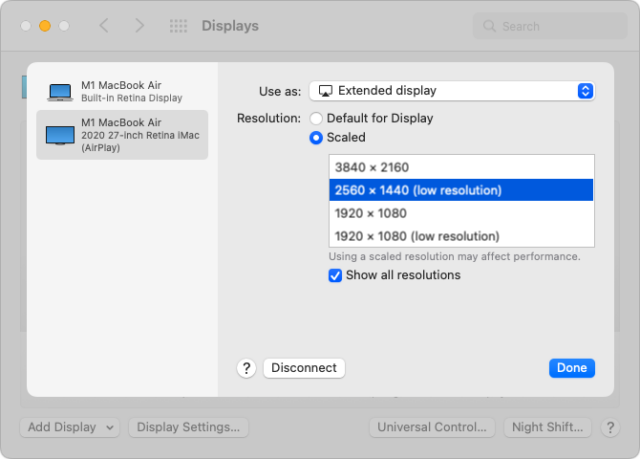
Thank you for this article.
My full-apartment sound system consists of a pair of HomePods in my living room, a HomePod Mini in my bedroom, and a desktop Mac (now a MacStudio with a Studio Display) in my office. For years, for most of the day, I have run the Music (formerly iTunes) app usually tuned to an Internet Radio Stream and used Airplay to send the sound to the HomePods. This has worked out well, but the limitation was that I was limited to using the Music app, as the general Mac audio system does not support streaming to multiple destinations. So, if I streamed to any of my remote destinations, I couldn’t even also get output on the Mac. So, I couldn’t listen to podcasts or streams from other apps or web browser-based streams using this setup.
Your article gave me the courage to try a setup based on my iPhone. Fortunately, the radio station also has an IOS app; so I set that up. After adjusting volumes appropriately, it seems to work out well.
So, for me, the one remaining hole in Apple’s remote speaker audio support is to have the Mac be able to stream like its own Music app. Like the mobile systems, it needs to allow streaming to multiple Airplay devices, but, unlike the other systems, it also needs to allow output to the audio to continue to play locally.
Until Apple achieves this level of streaming capability, I’m sticking with Rogue Amoeba’s Airfoil. It can stream any audio from the host Mac to any Airplay or Bluetooth audio destination (including the host), or to any device on the network running its Airfoil Satellite extension (included). TidBITS sponsor as well.
I’ve never been able to get Airfoil to do multiple-device streaming, nor stream to the Mac while streaming to remote speakers. That capability appears to be limited to the Music app.
meanwhile, i’ve been having issues with airplay from my mac.
just got myself a nice new pair of b&w formation duo wireless loudspeakers. work a treat playing from my iphone. sound spectacular (as one would hope; they ain’t cheap).
from the mac, not so much. constantly get dropouts. typically a glitch drops a beat or three. too often a break of seconds in the audio occurs.
searched the internets for possible solutions. no joy there. all i’ve found is similar complaints from other unhappy listeners, owners of other wireless speakers. some complaints date back to years ago.
why would airplay from the mac be so glitchy yet from the iphone mostly rock solid? any suggestions on how to troubleshoot this to make a case to apple support?
Huh. Don’t know what to say, other than “works for me.” As I type this, Airfoil on my iMac (the host) is streaming music to 1) Itself, via the headphone jack, 2) My Apple TV via Airfoil Satellite, 3) my MBP M1 Pro via Airfoil Satellite, and 4) my patio speakers via Bluetooth.
My use case is actually the use case of all my colleagues: we all have to teach via zoom/teams.
We want to use pdf viewers on the iPad, since they provide drawing tools together with an automatic “presentation” mode, which excludes the viewers from seeing the drawing tools’ palette. Such automatic presentation mode does not work while using zoom/teams directly on the iPad.
So, we use zoom/teams on the mac, we duplicate the iPad screen on a mac window via Airplay. Note that the iPad works with Airplay in presentation mode. From zoom/teams on the mac we share the airplay window with the iPad screen, and we are happy.
Now, there is a major issue with Airplay as implemented in Monterey: the iPad screen can be viewed on the mac only in full screen, and not within a window.
That’s why, we are still stuck using the Airserver app, which works perfectly since many years.
cheers
—e.
Yeah, that’s frustrating and I’m not sure why they did it that way. Technical or legal limitations?
Overcast iPad app runs on Apple Silicon Macs, just for anyone curious after reading this.
Thanks Josh for this information.
I will be able to display my iPhone on Mac.
It’s not that it’s complicated but the labels and the ergonomics are always changing and you don’t know where to look.
And the translation English - French not always evident.
iSO 15 brought me new changes totally without interest like renaming ‘preferences’ to ‘settings’, moving to the bottom what is at the top (url bar on Safari)…
My use case is going to be displaying photos on my 4k TV: iPhone → MacBook Pro → TV.
Why so complicated?
The use I plan to do is: